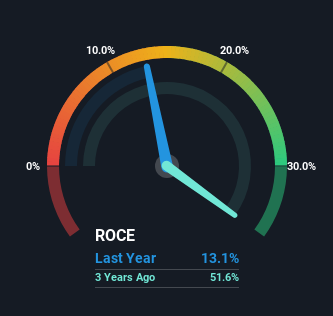Hubei Jianghan New Materials (SHSE:603281) Will Be Hoping To Turn Its Returns On Capital Around
If we want to find a potential multi-bagger, often there are underlying trends that can provide clues. Firstly, we'll want to see a proven return on capital employed (ROCE) that is increasing, and secondly, an expanding base of capital employed. Basically this means that a company has profitable initiatives that it can continue to reinvest in, which is a trait of a compounding machine. In light of that, when we looked at Hubei Jianghan New Materials (SHSE:603281) and its ROCE trend, we weren't exactly thrilled.
Understanding Return On Capital Employed (ROCE)
Just to clarify if you're unsure, ROCE is a metric for evaluating how much pre-tax income (in percentage terms) a company earns on the capital invested in its business. To calculate this metric for Hubei Jianghan New Materials, this is the formula:
Return on Capital Employed = Earnings Before Interest and Tax (EBIT) ÷ (Total Assets - Current Liabilities)
0.13 = CN¥651m ÷ (CN¥5.2b - CN¥279m) (Based on the trailing twelve months to March 2024).
Thus, Hubei Jianghan New Materials has an ROCE of 13%. On its own, that's a standard return, however it's much better than the 5.5% generated by the Chemicals industry.
Check out our latest analysis for Hubei Jianghan New Materials

In the above chart we have measured Hubei Jianghan New Materials' prior ROCE against its prior performance, but the future is arguably more important. If you'd like to see what analysts are forecasting going forward, you should check out our free analyst report for Hubei Jianghan New Materials .
So How Is Hubei Jianghan New Materials' ROCE Trending?
On the surface, the trend of ROCE at Hubei Jianghan New Materials doesn't inspire confidence. Around five years ago the returns on capital were 28%, but since then they've fallen to 13%. Given the business is employing more capital while revenue has slipped, this is a bit concerning. This could mean that the business is losing its competitive advantage or market share, because while more money is being put into ventures, it's actually producing a lower return - "less bang for their buck" per se.
On a related note, Hubei Jianghan New Materials has decreased its current liabilities to 5.3% of total assets. So we could link some of this to the decrease in ROCE. Effectively this means their suppliers or short-term creditors are funding less of the business, which reduces some elements of risk. Some would claim this reduces the business' efficiency at generating ROCE since it is now funding more of the operations with its own money.
The Bottom Line
We're a bit apprehensive about Hubei Jianghan New Materials because despite more capital being deployed in the business, returns on that capital and sales have both fallen. It should come as no surprise then that the stock has fallen 25% over the last year, so it looks like investors are recognizing these changes. That being the case, unless the underlying trends revert to a more positive trajectory, we'd consider looking elsewhere.
One more thing, we've spotted 1 warning sign facing Hubei Jianghan New Materials that you might find interesting.
While Hubei Jianghan New Materials isn't earning the highest return, check out this free list of companies that are earning high returns on equity with solid balance sheets.
Valuation is complex, but we're here to simplify it.
Discover if Hubei Jianghan New Materials might be undervalued or overvalued with our detailed analysis, featuring fair value estimates, potential risks, dividends, insider trades, and its financial condition.
Access Free AnalysisHave feedback on this article? Concerned about the content? Get in touch with us directly. Alternatively, email editorial-team (at) simplywallst.com.
This article by Simply Wall St is general in nature. We provide commentary based on historical data and analyst forecasts only using an unbiased methodology and our articles are not intended to be financial advice. It does not constitute a recommendation to buy or sell any stock, and does not take account of your objectives, or your financial situation. We aim to bring you long-term focused analysis driven by fundamental data. Note that our analysis may not factor in the latest price-sensitive company announcements or qualitative material. Simply Wall St has no position in any stocks mentioned.
About SHSE:603281
Hubei Jianghan New Materials
Develops, produces, and sells silane coupling agents, silane cross-linking agents, and other products in China.
Excellent balance sheet and fair value.
Market Insights
Community Narratives



